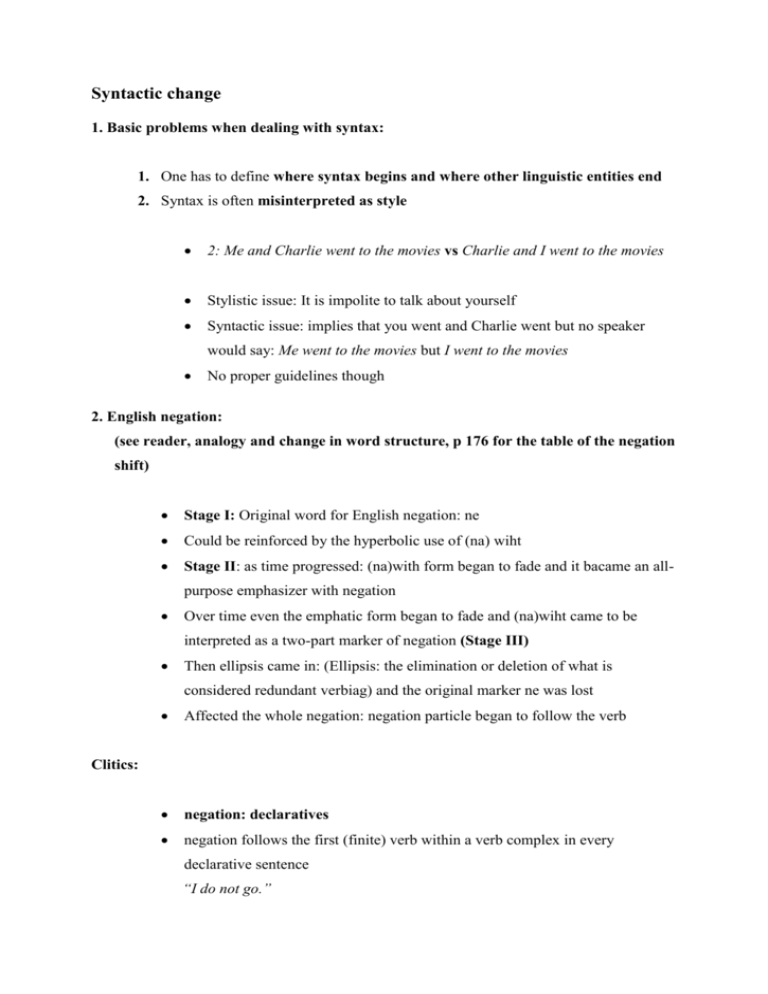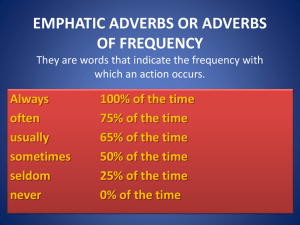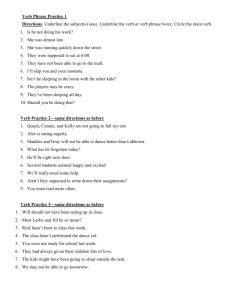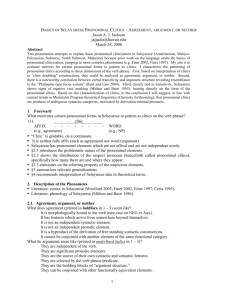Syntactic change - Homepage.ruhr-uni
advertisement

Syntactic change 1. Basic problems when dealing with syntax: 1. One has to define where syntax begins and where other linguistic entities end 2. Syntax is often misinterpreted as style 2: Me and Charlie went to the movies vs Charlie and I went to the movies Stylistic issue: It is impolite to talk about yourself Syntactic issue: implies that you went and Charlie went but no speaker would say: Me went to the movies but I went to the movies No proper guidelines though 2. English negation: (see reader, analogy and change in word structure, p 176 for the table of the negation shift) Stage I: Original word for English negation: ne Could be reinforced by the hyperbolic use of (na) wiht Stage II: as time progressed: (na)with form began to fade and it bacame an allpurpose emphasizer with negation Over time even the emphatic form began to fade and (na)wiht came to be interpreted as a two-part marker of negation (Stage III) Then ellipsis came in: (Ellipsis: the elimination or deletion of what is considered redundant verbiag) and the original marker ne was lost Affected the whole negation: negation particle began to follow the verb negation: declaratives negation follows the first (finite) verb within a verb complex in every Clitics: declarative sentence “I do not go.” negation: questions Finite Verb+S+Neg+rest of the verb complex “Do I not go?” negations: clitics The clitic has to lean on a host and n’t choose the immediately preceding word “I don’t go.” Questions with clitics:the negation moves with the finite verb (pied piping) “Don’t I go?” *”Do I n’t go.” pied piping: 3 solutions 1.: after the verb was fronted the rule of placing negation after the finite verb was reapplied but: we don’t use structures like “Am not I going?” 2.: clitic n’t simply needed a host and the finite verb happened to be available for that so that n’t had to move with the finite verb 3.: (non-syntactic answer) clitics simply became affixes and that’s why clitic n’t moves along with the verb just like 3rd person sgl -s 3. Syntax, analogy or both? A. Hopefully, it will rain tomorrow. B. *It is hopeful that it will rain tomorrow C. We are hopeful that it will rain tomorrow. Certain people state that the use of hopefully in structure A is ungrammatical It is said that A versions derive from B versions that contain a corresponding adjective to the attitudinal adverbs; compare: Fortunate A. Fortunately, it will rain tomorrow. B. It is fortunate that it will rain tomorrow C. We are fortunate it will rain tomorrow. Happy: A. Happily, it will rain tomorrow B. * It is happy that it will rain tomorrow C. We are happy that it will rain tomorrow. Must have derived from a c-version Development: The use of hopefully in structures like A is quite new Hopefully as an adverb existed in structures like “XY” said Mary hopefully which resembles sentences like “XY” said Mary happily Simple analogy (though syntactic but a ”proper” syntactic change includes the involvement of more than one word at a time) 4. Latin had a great influence on English syntax; the reason was the need for a prescriptive English grammar: 1. Double negation was condemned 2. In other constructions Latin rules were not adopted: relative pronouns and prepositions can stand at the end of a sentence 5. Word order in English as an example of complex syntactic shift ModEngl SVO TOPIC: marginal use: TOPIC S V.. Early Indo SOV European TOPIC: productive pattern TOPIC S…V Old English allowed for different structures because TOPIC was a productive pattern development from SOV pattern to SVO pattern development of the ModEngl sentence: The chicken had crossed the road o position of auxiliaries (2nd position) is an innovation and due to the fact that early Germanic auxiliaries had properties of clitics o One of the two auxiliaries be underwent clitic reduction (ist inPGmc and is in Old English) o There is the tendency for clitics to go to the second position in a clause. Its host is the topic: The chicken the road crossed had. o Other explanation: the auxiliary is finite while the main verb is marked and that’s why it moved into second position o Effects on sentences without auxiliaries: the finite main verb moves into second position: The chicken the road crossed. o At the end of the Old English period a further development affected syntax: the stranded main verb began to line up immediately behind the auxiliary because they functionally belong together: The chicken had the road crossed. o These changes took place in all European languages; German for example participated only in the first two changes: main clause finite verbs are in second position but non-finite verbs are left at the end of the clause Das Huhn überquerte die Strasse Das Huhn hatte die Strasse überquert .., dass das Huhn die Strasse überquert hatte. o initial topic sentences are still productive and in main clause structures the finite verb still directly follows the topic while the S comes after that o Problem: Die Mutter liebt das Kind. There is a lot of ambiguity and therefore such sentence structures should be avoided









